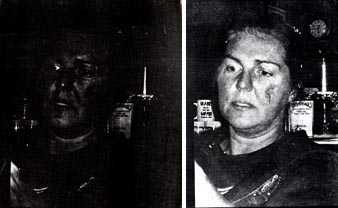
The first thing that will happen is that the unreduced dichromate (bright yellow) dichromate will immediately rush out of the print, as soon as you put it into the water. No pigment or gum leaves the print in that first minute or two, just the yellow dichromate. Then, in a few minutes the very lightest highlights of the print will appear. This is easier to see if the print is fairly high contrast:

At left is the print after 5 minutes in the water, with just the lightest hightlights developed; at right is the print developed as I wanted it for this print. It should be apparent (someone told me I need to make my explanations more basic, so I'm trying to do so here) that the process of development in gum works opposite from the process of development of, say, a silver print. With gum, the darkest tone (DMax) is already evident when the print goes into the water; development consists in soluble gum gradually dissolving into the water, along with the pigment suspended in it, to reveal the rest of the tones.
Correct exposure, as I explained in the page on exposure, is the minimum amount of exposure that will print the darkest tone that emulsion can print, and at the same time expose the lightest tones enough that they won't be lost while the midtones are being developed.
So if the highlights are lost before the midtones and lighter shadows are developed, the print isn't exposed enough. And of course if the print just simply washes off the paper, then it REALLY isn't exposed enough. On the other hand, if it takes longer than the standard time to develop the print, then it's overexposed. (Standard time for development has traditionally been about 30 minutes, but you can choose any time you prefer, as long as you understand that longer exposure --beyond an optimal amount-- isn't going to get you a darker DMax or more steps, it will just require a longer development to open up the same number of steps above the same DMax.)
At the same time, development may be used creatively to produce different effects. For example, in the example above, I was interested in a higher contrast print, isolating the face against a dark background, so I stopped development short of the standard time, before the darker midtones/shadows were developed, in order to enhance the contrast. If I left the print to develop longer, it would print with lower contrast. That lower-contrast, subtler tonality is what I usually prefer, but sometimes for an effect or to make a point for a demonstration, I choose a higher contrast development.
In the case of multiple printings, where you are using a heavier pigment mix for the dark values and a lighter pigment mix for the highlights, it's customary to use a somewhat shorter exposure for the heavier mix (long enough to produce DMax but not long enough to set in the lighter tones) possibly in combination with a longer development, to ensure that the heavier mix won't sully the highlight areas with its darker, coarser tones but will leave those areas free to express the smoother, subtler tones of the lighter mix.
Also,
Problems that may occur in development:
Copyright Katharine Thayer, all rights reserved